Assaults From Vehicles, Part I: Car vs. Pedestrian

In our Vehicle Fighting courses, we train on what to do if you are attacked IN or AROUND YOUR car, truck, or SUV.
This three-part series will mainly focus, instead, on what to do if you are attacked BY someone in, from, or even with THEIR vehicle, although there is some overlap.
Attacks from vehicles threaten three types of targets:
- Assailants in vehicles targeting pedestrians, including people on foot, skateboards, bicycles, or vehicles without a protective exoskeleton (such as scooters, motorcycles and Segways).
- Bad guys in vehicles targeting people in other cars, and
- Drive-by’s targeting structures (such as houses or businesses).
In this first installment, we’ll address what to do if you are attacked on foot or individual transportation.
Threats to Pedestrians & Cyclists
In the personal protection world, we tend to be concerned about malfeasance: intentional wrongdoing,
But when you are pedestrian, or unprotected on a two-wheeled conveyance (human or gas powered), the greatest threats to you are from unintentional negligence.
Accidental Threats
I learned that lesson early in life. As a paperboy, I was knocked off my bike while riding down the left side of the road (against traffic). Not yet having driven a car, I didn’t realize that people turning right are looking LEFT for oncoming traffic, which is why bicyclists are supposed to travel on the same (right, in the US) side of the road as the other vehicles.
Even those cycling on the correct side of the road (WITH TRAFFIC) are often the losers in car vs bike accidents. But you are still more likely to die from poor cardiovascular health than you are to be killed riding a bicycle, so take Freddy Mercury’s advice: “Get on your bikes and ride.”
Bright colored clothes & flashing lights can help.
Every motorcyclist knows that a single motorcycle headlight looks like a pair of car headlights a lot farther away, which is why drivers who don’t pay enough attention often pull out right in front of motorcycles, causing T-bone accidents. Bikers generally come out on the losing end of those.
If a car is in a position to pull out in front of you, looking at the car to guess its next move can be deceptive. Look at his wheels instead, to see if they are rolling.
On foot, try to hike AGAINST TRAFFIC, and bear in mind that people in cars may not see you. Don’t just launch into the street, even at a cross-walk. Remember,
There are many rights worth dying for.
The right-of-way is not one of them.
But chances are, you didn’t visit this website for a rehash of advice your dad or mom gave you already. So instead, we’ll turn our focus to intentional malfeasance.
Car vs Pedestrian Attacks
Drive-bys
If you are not a member of a street gang (if you are, please stop reading this and reconsider your life choices), you are not likely to be specifically targeted for a drive-by while on foot–that is, unless you piss off criminals for a living. I suppose, if gang bangers are just out for some target practice, you could be randomly selected.

Spree killers occasionally go mobile, shooting at random pedestrians from cars (for example, in Isla Vista, CA) but firearms attacks from vehicles against pedestrians are almost always targeting specific individuals or groups.
Vehicle Rampages (Ramming Attacks)
Attacking crowds of pedestrians–say, at bus stops–using vehicles AS weapons is becoming more popular among psychos / terrorists, especially in places where firearms are harder to obtain.

The obvious response is to GET OUT OF THE WAY, by the shortest straight line route possible. Unfortunately, many ramming attacks are carefully planned to run over crowds in places they can’t easily get out of the way, like on bridges or narrow streets between buildings.
Waukesha, WI: A Case Study of Vehicle Ramming
Before this sad sequence of events, Waukesha’s main claim to fame was as the birthplace of Lester William Polsfuss, known to every serious Rock’n’ Roll fan as Les Paul, musician and inventor of the electric guitar (in 1941, although Fender beat Gibson’s Les Paul guitars to mass production). Paul also invented multi-track recording, and numerous other innovations that altered the course of musical history.
“Your son, Lester, will never learn music.”
–A note from one of Les Paul’s teacher’s to his mother

Sadly, these days, Waukesha is more infamous as the location of a vehicle rampage, on 21 Nov 2021.
 A mass murderer drove his SUV through Waukesha’s annual Christmas parade. He bypassed signs prohibiting entry and drove through the marchers from behind. The portion of the parade route the psychopath chose was a section of Waukesha where the buildings are close together and the street relatively narrow, limiting opportunities for the pedestrians to escape.
A mass murderer drove his SUV through Waukesha’s annual Christmas parade. He bypassed signs prohibiting entry and drove through the marchers from behind. The portion of the parade route the psychopath chose was a section of Waukesha where the buildings are close together and the street relatively narrow, limiting opportunities for the pedestrians to escape.
Nearly a year later, my friend Ray and I walked through that parade route, to pay our respects and learn what we could.
We spoke with some city workers who told us what happened (but shall remain unnamed as they were not acting in an official capacity as spokespersons for Waukesha).
The killer plowed over victims ranging in age from 8 to 81.

The number of killed and wounded so frequently tallied by the news media, just like the body counts in Viet Nam, doesn’t tell the whole story. In ‘Nam, those estimating the body counts often erred in favor of higher over lower. With the victims at Waukesha, perhaps surprisingly, it was the other way around. Also victimized were parents who had to watch their kids getting run over, and children who saw their moms and grandmothers murdered.
Terrorism is theater.
A parade provides a captive audience.
One set of victims I had never thought about before I went to Waukesha are city workers who keep the streets clean and the signs up to date. They had to powerwash the blood off of the parade route when the investigators finally finished taking photos and sampling DNA.
Good luck forgetting that, boys.
In responding to vehicle rampages, we generally have two options: empty hands and firearms.
Empty Hands vs the Vehicle Rampage
I have a friend who once jumped into the back of a smuggler’s pickup truck, reached in through the open window, and half mata leoned the driver.

It worked, but often times a spree killer will not slow his vehicle enough to jump in (or in Ed’s case, on). The killer in Waukesha drove an estimated 40 mph through the crowd, zig zagging to improve his score.
Firearms vs the Vehicle Rampage
Although empty hands often stop active shootings in progress (more and more since it became acceptable to do), firearms are better tools against fast moving drivers. One officer shot at the Waukesha killer. But it did not stop him, and firearms vs moving vehicles pose a unique set of challenges.
For elaboration on armed response to ramming attacks, see Guided vs Unguided below.
Prevention of the Vehicle Rampage
Since so few of our typical tools work once a vehicle rampage has begun, prevention is the key. Breaking up plots through investigative methods happens more often than you think.
I know, because I used to be in that business.
Two areas where we are falling down on the job are letting killers out of jail and limiting access to parade routes (or pedestrian bridges, or other areas where victims are channelized into a long narrow space).
Preventing Recidivism
Obviously, if you’ve already arrested the killer for running over his girlfriend, perhaps you should keep him in jail (this would have prevented the Waukesha carnage). But that would involve enforcing the law, and several prosecutors, whose only job is to enforce the law, have run and been elected on a platform of not enforcing the law. The Waukesha killer was allowed to bond out even though he had failed to appear on previous charges for which he had been released on his own recognizance. This was not an isolated incident.
God bless America.
You can bond out after being arrested for failure to appear in court after the last time you bonded out. It didn’t start with COVID. It’s been going on for decades. Failure to appear should be an automatic bar to release the next time some cop has to find you.
Controlling Access to the Parade Route
Blocking access to the parade route is problematic because we need to allow access to floats and emergency vehicles. But it is essential.
Even large heavy “Road Closed” signs which may damage the killer’s vehicle generally won’t stop it. A former coworker of mine can tell you from first-hand experience that Road Closed signs won’t stop a full sized pickup, even if you plough squarely into them.
Physical Barriers
The military has been using physical barriers, such as bollards, Jersey barriers, and large boulders to channelize access to military bases for decades.

Pneumatically or hydraulically raised bollards can be raised fairly quickly. They can also be raised accidentally; one vehicle escorting federal prisoner Timothy McVeigh wound up doing a ski jump over a barrier as it was being raised.
The main drawback of bollards is that they are expensive to install and semi-permanent. Military bases are quasi-permanent facilities, so bollards and boulders work fine for them.
Parades are different. Cross streets need to be open the day before the parade or bicycle race, but closed during. After the parade or bike race or whatever has ended, we need to be able to allow traffic to flow normally again in short order.
Jersey barriers are ubiquitous. Some construction company probably has some near by they would be happy to rent; or they may already be owned by the state or county roads department. But Jersey barriers don’t move themselves. You’ll need a forklift and probably a flatbed.
The Waukesha city workers showed us pictures of a complex system of barriers produced in Israel that the city was considering procuring. They are L-shaped; a vehicle hitting them fast enough would get high-centered as they tip over. They also appear to be portable.

“I don’t know why we don’t just use our snowplows,” asked one of the city workers. “We could completely block streets to cars with snowplows. And they would be easy to remove afterward.”
The sad answer I gave them is that expensive, high-tech Israeli barriers are prettier and look progressive–like we are responding to new challenges with new tech. Snowploughs aren’t just unattractive. Using that pre-paid, already extant option would beg the question of why there weren’t snowplows blocking access to the parade route on 21 Nov 2022.
The fact that it wasn’t thought of because vehicle rampages had never been a problem before in Waukesha would probably not assuage some of the victims’ relatives.
This is not me Monday morning quarterbacking. It’s just a sad observation after many years of re-inventing the wheel in the public safety business. Nobody likes security until they needed it the day before. And then the politicians, left or right, are more concerned about deflecting blame than they are about fixing the problem, because we live in a litigious society and everyone is eager to blame anybody except the person on whom the culpability lies: the killer.
The Redneck Toss
On a lighter note, pedestrians and cyclists in the US are far more likely to be randomly targeted by idiots throwing things at them than run over by them. Eggs are more common than rocks; beer or soda cans that are mostly empty (but still have a little fluid to give them momentum) are probably tossed more often than either.
As a teen, I was walking against traffic when a model citizen tossed a beer can at me. I caught it, getting sprayed in the process, and turned to throw it back at the car, but then realized it was half full. It was a hot day, and I’d been walking for a while. Being a teen and unable to buy my own, I raised it to them in a toast. As the straw man sang, “. . . if I only had a brain.”
Abducting Joggers (Primarily Females)
Again, you are far more likely to die early from poor cardiovascular health than from violent crime, so by all means, keep (or start) walking, jogging, or running, or doing Zumba, or whatever.
Women who run by roadsides are sometimes abducted by someone in a vehicle, either pointing a gun at them and telling them to get in, or, in extreme cases, being struck BY the vehicle and then waking up tied up in some rapist’s house.
The soundproofed dungeon is lurid fodder in a disturbing number of Hollyweird fantasies. There are serial killers who go to such lengths, but more often, these scumbags are opportunists, and the wide open spaces of the Rocky Mountain west & midwestern plains, or the deserted factories and slag heaps of the Rust Belt, or the thick woods and swamps of the Southeast, provide them with all the isolation they need. Women (or children) are driven to an isolated area, raped in or on the vehicle, and then killed or left for dead.

This is something we specifically address and train for in our Ladies’ Personal Protection classes. We talk about the 2 crime scenes:
- Where the abduction takes place, and
- Where they find the body.
In the Eastern US, or in crowded cities, the second crime scene can be 10 feet away from the first, behind a dumpster or in a vestibule.
The Western US did a lot of its growing up after the advent of the automobile, so the roads are wider, the cities are more spread out, and there is less public transportation. The automobile is an essential part of the western lifestyle, and most of us can hardly imagine life without one.
Women walking through a parking lot after work (or, more often, after leaving a bar) are often abducted in their own or others’ vehicles.

Said it before, and I’ll say it again:
Avoid going to the second crime scene at all costs.
It behooves us to take our chances running or resisting NOW, rather than getting in the car with them and going where there are fewer potential witnesses.

Obviously, if this is an assassination (drive-by SHOOTING) rather than a kidnap, and he’s already gunning for you, running or resisting now is a no-brainer.
If you are getting in the car and he runs up behind you, forcing you into the passenger seat, keep going and bail out the other side. He will try to pull you back in; feel free to kick him in the teeth, even if he has a gun or knife. If he wanted to kill you right there, he would be doing so already. If he is, resisting costs you nothing, and could gain you the rest of your life.

If he jumps in your passenger side as you get in the driver’s seat, abandon the car and RUN TO THE REAR. We discuss why further on in this article.
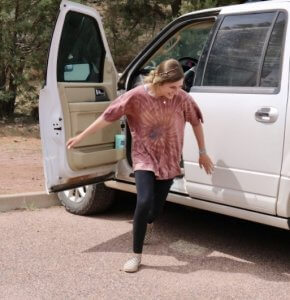
If he jumps out, points a gun at you, and tells you to drive as he climbs in the back seat, DON’T GET IN. RUN, NOW.
If you’re in the driver’s seat and you are suddenly startled by the sight of him in your rear view mirror, in the back seat, bail out and run. If the car is already in motion, stop it if you can. If he threatens you as you slow down, speed up instead and run it into something, preferably where there are witnesses nearby. People ignore car alarms, but everybody looks up when they see a car crash (wear your seatbelt).
If he has you by the neck with a knife to your throat, and you are fortunate enough to have a gun on you, first secure his knife wrist with your non-gun hand. Shoot him UNDER YOUR ARM rather than over your shoulder. It’s harder for him to off-line or control it that way.
As with all these methods, it’s important to practice these and learn them by feel, rather than just reading or talking about it.

A lot of this could be avoided if you look at your back seat before jumping in. Which brings us to:
Awareness to Avoid Vehicle vs Pedestrian Attacks
I met a woman who was walking through a shopping center parking lot–in broad daylight–when a truck pulled up close to her from behind, on her left side. She never saw the guy who hit her with a baseball bat, knocking her down. No quid pro quo “give me your purse or I’ll stab you,” just a premeditated, potentially lethal assault, followed by a robbery. She could just as easily have woken up in a trunk–or DRT (dead right there).
If you’ve been in our classes before (and we’re far from the only ones who teach this), you’ll know that Situational Awareness (SA) can turn a Flash Fight into a Brewing Fight. All fights stew a little before they flash over, but most people are too wrapped up in their own little worlds (or their cellular screens) to pay much attention to what’s going on around them; consequently, when they find themselves in a fight, it completely surprises them.
Interviews with prison inmates have revealed, time and again, that if you are visibly paying attention to what’s going on around you, you are less likely to be targeted as a victim of violent street crime.
However, if someone has decided to gun you down by the side of the road, or kidnap you, from a vehicle, that’s pretty premeditated. Having a car means they can start their run on you from farther away than the typical street thug on foot who mugs or rapes at conversational distances. It also means they can get away faster, so they are less likely to be deterred by your paying attention.
Rather, your attentiveness to your surroundings, particularly to the windows of cars approaching you, can buy you time to get out of the way of their soon-to-be incoming fire.

When I walk through my neighborhood, I enjoy the fresh air and the chirping of birds and the early morning (or late afternoon) sunlight on the Catalina Mountains. I also try to (it bears repeating here) walk on the side opposing traffic, and give at least a passing glance to any cars that are approaching. In other words, I’m in what Jeff Cooper called Condition Yellow.
If a window or windows are down on my side, I give the car a second glance. If there are passengers on that side, I pay extra attention (Condition Orange, which is ONLY increased scrutiny, NOT a state of alarm). I’m not paranoid about it, but I am aware that if the window is down, there is a very, very remote possibility of a drive-by threat–especially if it is very hot or very cold, when most people have all their windows up. Orange only means that your radar has switched from wide beam to narrow focus. It doesn’t mean we’re launching jets.
When you drive, you shift from Yellow to Orange (“That guy’s drifting into my lane”) and back to Yellow (“–oh good, he must’ve stopped texting”) frequently and seamlessly, without any real heartache.
I myself often cruise with the windows down when the weather is nice. I might even hang an elbow out my side. It doesn’t make me a member of MS-13.
But if I’m by the road and anybody is hanging anything out of their window on my side, that would be cause to switch into Condition Red.
Red is poorly understood. It doesn’t mean we are fighting (or running) yet, but in Red, something is definitely wrong. We get serious about possible reactive options in Red, and set mental triggers. To use an analogy that arose out of the Cold War, our DefCon has changed.
Immediate Action for Vehicle vs Pedestrian
So what to do if you see not only that the window(s) on your side are down, but somebody on your side of the vehicle hanging a gun or guns out the window?
MOVING IS YOUR FIRST, BEST COUNTERMEASURE.
It’s hard enough to hit from a moving vehicle. It’s harder still if your target is also moving, UNLESS IT’S MOVING IN THE SAME DIRECTION. I cannot emphasize this enough:
ALWAYS RUN TO THE REAR.
Take a tip from the Luftwaffe, and add your speed to theirs, rather than matching or subtracting it (see Appendix, Combined Airspeed, for details).
Drive-by drills
One of the best ways to train response to drive-bys is to see it from the drive-by shooter’s perspective.
In Heloderm courses, we use Airsoft, or marking cartridges such as UTM or Simunition FX.
We roll through a rotation where an instructor drives, one student is in the front passenger seat with an Airsoft rifle or pistol, and another student (in protective gear) plays the role of a pedestrian.

The first version we run is a Kobayashi Maru. Star Trek fans can tell you, that means a no-win situation. The pedestrian student, regardless of their intial direction of travel, runs the same direction as the front of the car. The driver accelerates only fast enough to match their speed. The student in the passenger seat nails them repeatedly with Airsoft (or marking cartridges). The lesson here: going the same direction they are gets you shot.
A lot.

Then we have them use the School Solution: Run in the opposite direction from the car (again, the mantra is: “Run to the Rear“). This is no guarantee against getting shot, but it gets you shot a whole lot less.

After Seeing It from the Bad Guy’s Perspective
Then we have the shooter “suit up” in protective gear and play the pedestrian, while we rotate in a new drive-by shooter, till all the students have been in both roles. Experiencing it both ways, from the sending and receiving end, greatly enhances their understanding of the “run to the rear” concept.
Essential HTE Gear
As a reminder, essential protective gear for HTE (human target engagement) exercises includes:
- Full wrap around head protection (a motorcycle helmet works great)
- Neck protection
- Hand protection (leather gloves work fine)
- Groin protection
Unless the role player is a dedicated “bad guy,” further protective equipment is counterproductive.
HTE is some of the most effective training out there, but it can be very dangerous if not done properly. For one thing, you should screen–and then double check–for live weapons sneaking into your scenarios. I suggest you read all of Kenneth R. Murray’s Training at the Speed of Life before attempting HTE training on your own.
Initial vs Eventual Response
Of course the binary choice of only running along the road, either in the direction of the car’s front or back, is grossly over-simplified. At some point you are likely to break away from the road and into cover or concealment or duck between a pair of parked cars and hook around by the engine block of one, if possible. But your INITIAL movement should be toward the rear of the bad guy’s vehicle, regardless of your initial direction of movement or theirs, because it’s simply harder to track your movement from inside the car that way, unless they are shooting from the bed of a pickup truck, or have a station wagon with a seat set up facing backward.

If you start by running directly away, perpendicular to the road, you stay on the Railroad Tracks of the bad guy’s bullets, which you cannot outrun.
Why not shoot back?
We generally do not teach you to return fire at a moving vehicle.
There are a few reasons.
Not too long ago, I had just locked myself onto my front porch, which has a wall with a gate around it, when I heard a high pitched buzzing noise. A rattlesnake was approaching me under the gate, coming around the corner of the wall, pointing it’s shovel-shaped head directly at me, and S-curving the back half of it’s body against the wall to give it something to push off of, should I not comply with its warning.
For a few moments there, that snake had my undivided attention; a good example of Condition Red. Denzel Washington could’ve been standing on the other side of the gate, and I wouldn’t have noticed him until after I started looking around for exit routes.
It’s safe to assume that if someone is shooting a gun at you, you will be “living in the moment.” My limited experience with these things is that there is a clarity of focus in gun battles which usually does not exist in the fog of my day-to-day life.
Despite our best efforts–we put “NO SHOOTs” in, around, and behind most of our target arrays in my live fire classes, and you should, too–chances of your paying a great deal of attention to what’s going on behind the guy trying to end your life are slim (still, it is a goal to shoot for).

If that guy is in a moving vehicle, what’s behind him will be changing constantly. Drive-bys are far more likely to occur in a neighborhood or business district than along Italian Spring trail in Saguaro National Monument (where there are fewer occupied structures to worry about).
Navy SEAL Jeff Gonzales told me “The best bullet trap is your threat.” Chances of missing a moving target are higher if your threat is moving, requiring even greater concentration on your threat and the front sight, and decreasing your chances of paying enough attention to what’s going on behind your threat.
Who else is in the vehicle?
Certainly, a driver who permits someone to shoot out of his or her car is a willing accomplice who is equally culpable under the law. But if you hit that driver in the head, you’ve just turned that moving vehicle into an unguided missile, hurtling through your neighborhood and perhaps into opposing traffic.
As Mas (pronounced “mass,” not “moss”) Ayoob points out, if every officer on your police department fired all their ammo at once at a moving vehicle, they still wouldn’t come near to matching the potential energy that vehicle is hurtling toward them.
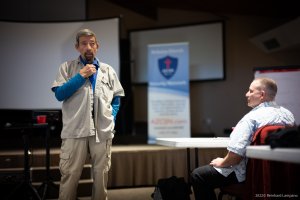
A few years ago, several of my coworkers were conducting a night-time controlled delivery (a type of drug bust) in a parking lot. As federal agents and TFOs moved in, the driver panicked and tried to run over two of them. They shot at the car.
One agent–let’s call him “Ivan”–struck the car with a shotgun blast.
The other agent, “Dan,” was running out of the way, firing his M-4 at the driver. Despite the fact that both the agent and the driver were moving, Dan fired a really tight group (Dan and Ivan were also my firearms students, and I’m quite proud of them).
Investigators put dowels tracking the path of each bullet in the holes later. I saw the dowels (I wasn’t in the parking lot that night) and the very compact group entered the driver’s side window just over the mirror, spreading out in a fan as Dan moved out of the way and the car moved toward his last known address. Most of the dowels went through the driver’s headrest.
And fanned out over the occupied child’s car seat in the back.
I find it difficult to use polite words here. The suspect had brought his baby to a several hundred pound drug deal.
Never too early to start teaching your kid usable skills.
Incidentally, there was zero whining about “separating families” when perpetrator was carted off to jail and his kid was turned over to child protective services.
Other People in the Car
Whether they are goading him on or not, other people in the car will inevitably claim “no one was more surprised than I when he pulled out a gun and shot at that person on the sidewalk” after you paralyze them for life and they file a tort claim demanding compensation for medical bills, loss of consortium, and emotional anguish.
If the bad guys stop the car, get out, and pursue you, that’s another situation entirely. Feel free to rock their worlds with return fire–as long as there’s nobody behind them (see Threats from Parked or Stopping Vehicles below).

Even if the vehicle is stopped, unless the shooters are in the back of a station wagon or pickup truck, it’s generally harder to engage targets to the rear from inside the vehicle.
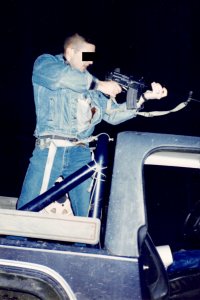
Down Angle Shooting
One exception to not shooting at moving vehicles is if your own kids are in the car.
Wait–what?!?
Not once but twice, when my beautiful bride was a new mother, she carefully strapped our baby into the car seat, and then drove off–without the groceries. She cried and said she felt foolish, but I consoled her with the fact that if she was going to forget one or the other, she forgot the right things. We can always get more groceries.
Most parents strap their kids in first, then load the groceries. If the weather is very hot or very cold, they might turn on the car to get the AC or the heater working.
Then the responsible ones put the shopping cart in the cart corral.
If you’ve been a model citizen and turn around to see an opportunistic carjacker jumping in your driver’s seat, you’d better act now.

This is not a hugely likely scenario. It can be even less likely if you carry two sets of keys and lock the door with the window up before pushing the cart across the parking lot aisle. At least they’d have to sit in broken glass to drive away with your kids.
Run over there, and point your pistol through the windshield at their groin. This is to minimize risk to the precious passengers in the car. It’s a method we practiced frequently when I was on rescue teams for undercover operators meeting crooks in cars.

Yell at him to STOP! THE! CAR! NOW!
If he does, tell him to put it in park (or set the parking brake), put his hands up, and slowly exit the vehicle. Then tell him to go away.
You will probably want to kill him for threatening your kids. Don’t shoot him unless you feel your life is in danger. We do NOT try to apprehend him because our first job is to protect those kids, and as long as he’s around he’s a potential danger to them and you. Cornered animals are the most dangerous. Let the detectives catch him later.
If he keeps backing out of the parking space and doesn’t stop, or worse yet, throws it in forward gear, shoot him, now.
There is a danger from fragmented or powdered glass inside the cab getting into eyes–either directly, or from dusted hands rubbing tears from eyes later. The threats to them are far greater if you let the carjacker / kidnapper drive off with them.
Rooftop Counter-snipers
One way to prevent shooting through a moving car and hitting unintended subjects on the other side is to shoot down into the rampage vehicle from above. Placing marksmen on rooftops during parades might have stopped the Independence Day parade sniper who attacked Highland Park, Illinois on 04 Jul 2022.
No police department that is serious about keeping its citizenry safe should be without rooftop counter-snipers, whenever and wherever large crowds are gathered in the active killer era.
I once worked plainclothes to protect protesters and counter-protesters at a “Draw Muhammed” event. The local PD had marksmen on nearby structures. We were given specific instructions NOT to draw our weapons if there was violence, so that we would not be mistaken for any active killers.
While it is not without some IFF issues (identification, friend or foe), shooting a rifle at a downward angle from a roof or parking garage eliminates a lot of shoot-through issues that would be caused by shooting from street level at a moving car.
Guided vs Unguided
As with kidnapping in progress, another exception to “we generally don’t shoot at moving vehicles” is if the driver is using the vehicle AS a weapon, i.e., ramming attacks / vehicle rampages.
On my last overseas tour, I occasionally relieved our M240B gunners when they went to chow. Each Entry Control Point, or ECP, had a belt fed, 7.62x51mm machine gun overwatching it from a quasi-hardened tower (the front windows, which slid open to allow firing, were only plexiglass).
The theory was, if a VBIED (vehicle borne improvised explosive device, i.e., a car or truck bomb)–or for that matter, simply a van full of terrorists with small arms–ran the gate, the M240B could make short work of it.
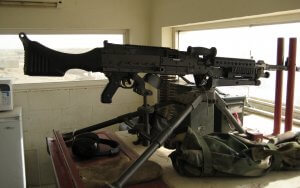
I found it amusing that our SSIs, Special Security Instructions–which had been approved by some level of command and possibly vetted through the base legal office by attorneys familiar with our SOF (status of forces) agreement with the host nation–stated that, if at all possible, we were to target the engine of a gate runner, rather than the driver.
Very noble. After all, it could simply be a case of mistaken identity: a lost driver who couldn’t turn around in the rat’s maze of Jersey barriers leading up to the gate, and panicked.
But it was also preposterous.
There were two gigantic problems with that particular SSI, holes in their logic big enough to fly an imperial star destroyer through:
- Although the M240B had a much finer front sight than that of the M60 it replaced, it’s still a belt-fed machine gun. It was designed for spewing bullets over a wide area (we call that the “cone of fire”), rather than precision sniping. Even with a tripod and “T&E” (traversing and elevating mechanism), if the target is moving at all, much less a speeding car, it’s just not possible to successfully confine the bursts of machine gun fire to one part of it. The very idea suggests a level of control over the cone of fire which simply does not exist. The driver was likely to get some rounds in the chest, no matter which part of the car we were trying to hit.
- Secondly, the most critical part of a VBIED is the guidance and fusing mechanism–i.e., the driver. HE or SHE determines where it will go. The driver alone can select alternate targets of opportunity, either unexpected targets of higher value which come into view, or pre-planned secondary targets if the route to the primary is blocked. Although the VBIED may have remote detonation should the driver lose his or her nerve, as a general rule, the driver decides when to set off the bomb. The driver who hit the USMC barracks in Beirut, for example, waited till after he plowed the Mercedes truck through to an atrium in the center of the building.
In other words, the driver of a VBIED is a legitimate target, and a lot easier to put out of action than an engine–especially with pistol bullets. Pistol bullets will even, sometimes, bounce off of tires, and vehicles can run for miles on the rims. A .50 cal BMG round will put a truck engine out of commission. Your concealed carry handgun, not so much.
Although we generally avoid shooting at moving automobiles for fear of turning them into unguided missiles, the driver in a ramming attack also constitutes a legitimate and logical target for your small arms fire.
Because he IS the guidance system. Without the driver to correct the steering, it will be a lot easier for the pedestrians in front of the vehicle to leap out of the way.
In short,
Better an unguided missile than a guided one.
Threats from Parked or Stopping Vehicles
There are two reasons the vehicle might be stopped:
- Reaction to your movement
- Pegged surveillance
Reaction to Your Movement
If they are moving and about to shoot you, but you suddenly run to the rear, the driver might stop to help the gunner by keeping you in their kill zone longer. A vehicle has a roving kill zone around it, and if it is moving in the opposite direction, it’s not a threat to you as long.

Pegged Surveillance
When I was a criminal investigator, sometimes roving surveillance was less of an option, so we would station cars along likely routes and call out on the radio net as the suspect vehicle went past. This is called pegged surveillance.
If you follow the same route every day, bad guys might wait in ambush for you, parked on the curb you regularly walk past. This enables them to hop out to finish you off before jumping back in and using the mobility of the vehicle for a rapid get away.
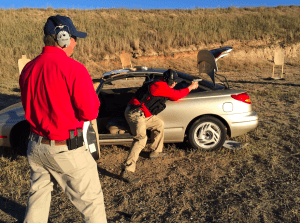
These days, responsible drivers sometimes pull over to text. But
if you ever see anybody just sitting in a car along your walking route, especially if there are two of them, cross over to the other side of the street and watch what they do.
If they seem to be paying attention–or worse yet, reacting–to you, don’t be too inflexible to change your entire route of travel to avoid them, just to be sure.
If they get out, MOVE, NOW.

You may need to move quickly around a corner in the parking lot, then get your gun out, and / or prepare to counter-ambush them.

Appendix:
Combined Airspeed
In World War II, when American bombers flew their nearly suicidal daylight bombing missions against Nazi Germany, Luftwaffe fighters intercepted them.
The F and G variants of the German Messerschmitt Bf 109 had maximum airspeeds of 380+ miles per hour.
The American Boeing B-17s, on the other hand, lumbered along much slower. The G and E variants of the B-17 had maximum airspeeds of 287 to 317 mph, but when laden with bombs and fuel they probably were moving at closer to 200. Actual airspeed depended on a variety of factors, including altitude, supercharging, etc, but suffice it to say that the B-17s and B-24s were much slower than any of the fighters attacking them.

It was easy for a faster fighter to catch up with a slower bomber and shoot it down from behind–which is why each B-17 had ten to thirteen .50 caliber machine guns, several of which could point to the rear. Attacking a moderately sized 300 bomber formation meant facing 3000+ machine guns (late in the war, thousand bomber raids were not unheard of).
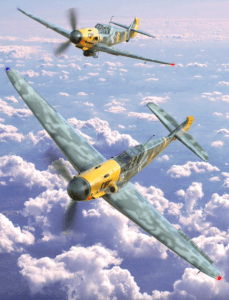 If the bombers were within the range of the fighter’s cannons, the fighter was within the range of the bomber’s guns. It’s easy for a scared 19 year old to hit you if you are flying within range of him at about the same speed and direction.
If the bombers were within the range of the fighter’s cannons, the fighter was within the range of the bomber’s guns. It’s easy for a scared 19 year old to hit you if you are flying within range of him at about the same speed and direction.
It didn’t take long for the Luftwaffe fighter pilots to figure out the simple math that if they combined their airspeeds by attacking from the front, instead, they would be passing through that storm cloud of .50 caliber bullets at 200 + 350 = well over 500 combined miles per hour. It was much harder for the Luftwaffe pilots to hit even a big bomber at that speed, but also much harder to BE hit by all those aerial gunners from Nebraska and the Bronx.
And, as with any gunfights you may find yourself in, not being hit was a lot more important than hitting the other guy.
Like those fighters in WWII, you improve your survivability when you you RUN TO THE REAR of a vehicle doing a drive-by on you. You combine your speed with theirs.

–George H, lead instructor, Heloderm LLC
